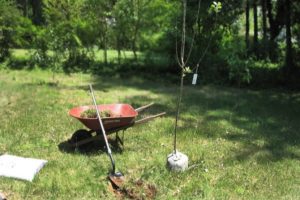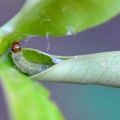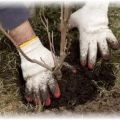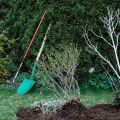What to do if the leaves are covered with cobwebs on the apple tree, how to deal with it and how to treat it
Almost no garden is complete without apple trees. Fruits, rich in vitamins and microelements necessary for a person, are liked by adults and children. Beautiful, covered with snow-white flowers or bending under the weight of the harvest, tree branches are a source of pride for a gardener. Therefore, it is especially offensive if a cobweb appears on the apple trees, they are affected by diseases and pests.
The source of the cobweb and signs of damage to the apple tree
If a cobweb has appeared on the apple trees, this is a sign that the trees have been attacked by pests. Most often these are different types of caterpillars. If a problem is found, it is necessary to immediately process the apple tree, otherwise you can be left not only without a crop, but also lose the fruit tree. What insects can cause the appearance of cobwebs on an apple tree and how to deal with them, this will be discussed.
Apple moth
This pest of fruit trees is known to gardeners as the ermine moth. Caterpillars are dangerous for apple trees. Their ability to protect themselves from frost with shields allows insects to survive the cold, and when the temperature is above zero, the pests are activated.Caterpillars intensively feed on greens for almost one and a half months, gnawed leaves curl and dry. And then the pest pupates in a nest formed from a web.
After a couple of weeks, a small silvery-white butterfly appears, which lays several dozen eggs covered with a protective shield. The butterfly creates a clutch on the bark of young tree branches.
If the apple tree is not treated in a timely manner, the pest can destroy a young seedling and even an adult tree. Deprived of foliage, entangled in cobwebs, apple trees make a depressing sight, and often cannot stand frosty winters.
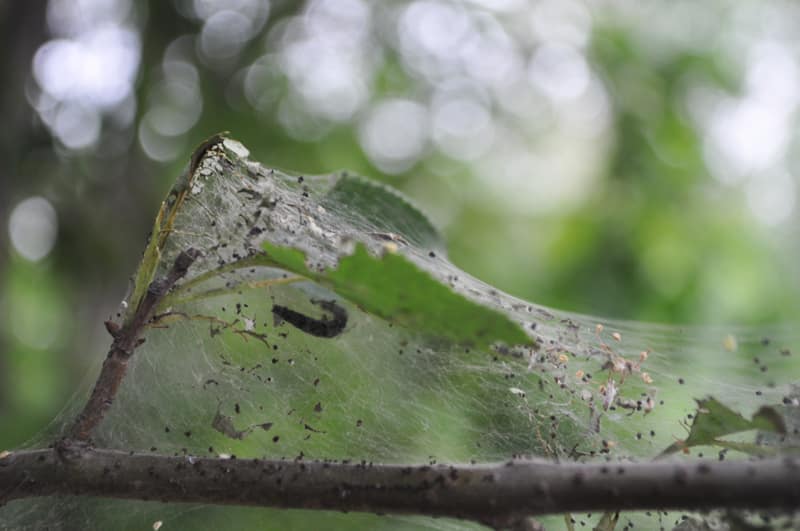
Winter moth
The brown-gray butterfly with underdeveloped wings, unable to fly, is the female of the winter moth. The harmful insect destroys up to half of the leaves on the tree, and affects fruit (pears, apple trees) and most other deciduous trees.
Males of this pest are light gray in color, with rounded edges of the wings. Butterflies of this species appear in the garden when the summer heat subsides. They can lay eggs until mid-December. They are not afraid of temperatures down to -15 ° C. These insects are active in the evening and at night.The female lays eggs under the bark of trees, on branches, at the base of the buds.
The emerging bright yellowish-green caterpillars with a dark stripe on the back very quickly destroy delicate buds and fresh green leaves. Caterpillars are active for a month, then they descend along a web woven in leaves, pupate, climbing underground in the area of the trunk circle, and wait for autumn.

Unpaired silkworm
Butterflies belong to the waffle family. Females are distinguished by a thick, cylindrical abdomen and white wings. Males have light brown, dark patterns, wings and a slender abdomen. Individuals are active in the evening. Males fertilize females sitting on the bark of trees, they lay a huge number of eggs on the bark. There can be up to 1000 of them in a masonry.
In the spring, caterpillars appear from the eggs, the large bristles of which allow them to be carried over considerable distances with gusts of wind. The small caterpillar is yellow, the adult is dark, almost black. The unpaired silkworm destroys the buds, leaves, flowers of the plant. The development period of caterpillars takes 30-50 days, during which time they destroy deciduous trees over a large area, and then pupate.

Ringed silkworm
Butterflies of this species are also called ringed cocoons. Females are much larger than males. All individuals are colored in shades of brown, depending on the region of distribution, they can be light or dark in color.
For laying eggs, the butterfly prefers young thin branches, placing eggs in an even ring.
Caterpillars are large, up to 5.5 centimeters long, with bright multi-colored (white, blue, orange) stripes and bristles characteristic of the silkworm. They appear during the period of swelling of the buds, destroy them and young leaves, while forming huge lumps of cobwebs.
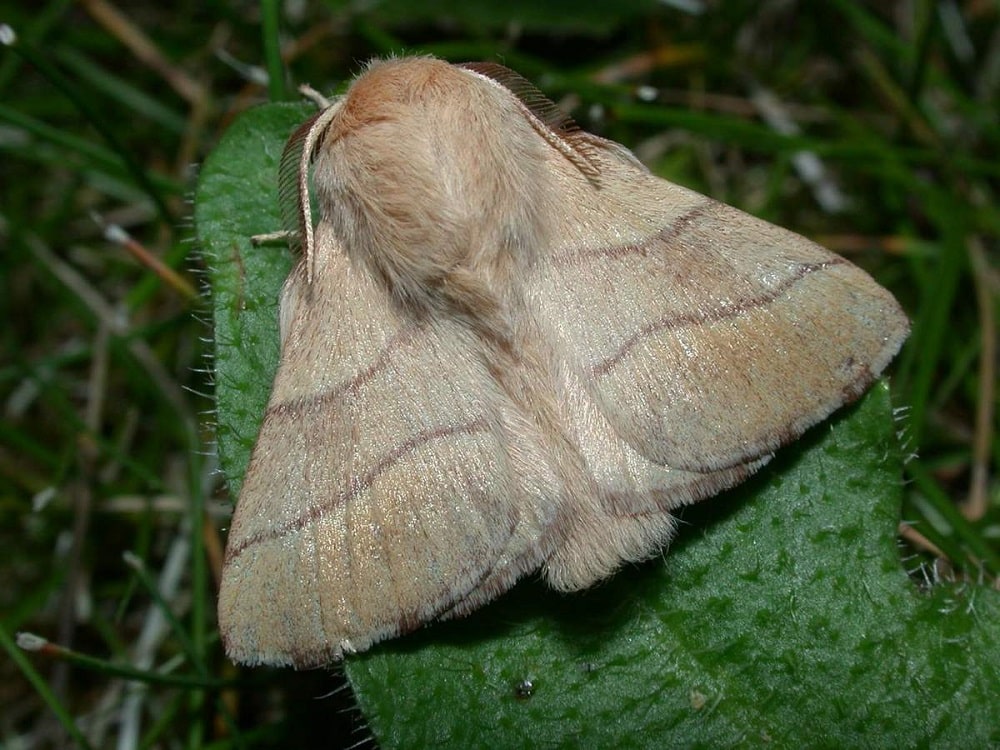
Apple honeydew
The name of the louse, which this insect has, is caused by the small size of the pest. It is greenish in color, with transparent wings, about 3 millimeters long. By the end of the summer season, individuals become darker. The insect lays eggs in the folds of the bark, on the kidney bases. In the spring, larvae appear from them, which, growing up, are able to destroy all parts of the apple tree (buds, greens, even young bark).
Spider mite
Small arthropod insect from the arachnid family. Individuals - up to 1 millimeter, transparent, greenish, eventually turn red or brown. Pests feed on plant sap. They reproduce especially actively in dry hot weather. These pests are capable of attacking trees of different species. When a spider mite spreads in the garden, when the weather is favorable for it, all trees and shrubs are covered with cobwebs.

Spider aphid
This pest appears along with a spider mite. Aphids quickly attack young juicy parts of the apple tree. It also feeds on plant sap, the leaves affected by the pest first swell, changing color, and then dry out.
How to treat an apple orchard for cobwebs
Answering the question of what to do if a cobweb appears on the branches of apple trees, it should be noted that there are many effective ways to deal with cobwebs in the garden. These are folk remedies used in the initial stages of infection, and complex industrial insecticides that help defeat pests in case of serious damage to the garden. Of course, each gardener decides for himself how to deal with the misfortune.
Folk remedies
Folk remedies involve the use of decoctions of medicinal herbs (celandine, yarrow, dandelion, tansy) for spraying fruit trees.

Important: such funds can be used every 4 weeks, the main thing is to alternate them, since pests quickly get used to them.
In addition, plantings are sprayed with shag or onion husk infusion.Effective against caterpillars using a mixture of wood ash and laundry soap.
Chemicals
When choosing how to treat apple trees from pests, you should prefer complex agents that are effective against most insects. For example: Fufanon, Karbofos, Tanrek, Fitoverm. Today, biological preparations have appeared that protect against pests; they are distinguished by their safety and efficiency of use.
Bitoxibaccillin
The drug is harmless to humans and insects, but destroys most garden pests (adults and larvae). It is used in strict accordance with the instructions.
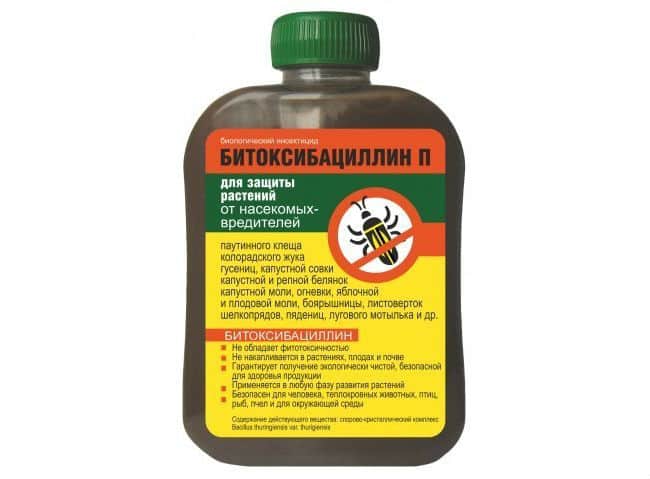
Bicol
A biological product related to bacteriological plant protection agents is effective against a huge number of garden pests (about 80) and is safe for humans.
Endobacterin
An effective preparation suitable for controlling most types of caterpillars and other pests of garden trees. More effective in warm weather. From caterpillars and butterflies, 2 treatments are carried out with an interval of 7-10 days.
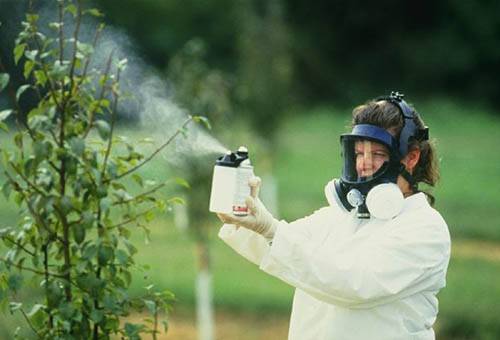
Spraying with biological agents
Produced in warm, dry weather, in strict accordance with the manufacturer's instructions. To avoid an allergic reaction, you should wear safety glasses, gloves, and protect your respiratory system.
Mechanical method of dealing with apple moth
Mechanical control methods apple moth include arrangement:
- birdhouses that kill garden pests;
- pheromone traps that lure males away from fertilizing females;
- trapping belts.
Some species of wasps destroy the caterpillars of the apple moth by laying their eggs in them.
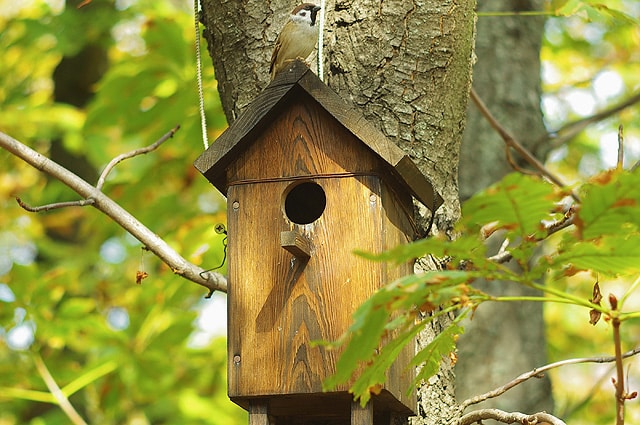
Agrotechnical techniques
They include timely disposal of weeds, digging up the root circle of apple trees, whitewashing the trunks and, if necessary, treating the trees with garden pitch. Pruning trees on time also helps to reduce the likelihood of pest spread.
The timing of the treatment
To protect the apple trees from the invasion of caterpillars, the trees are processed several times per season..
Before bud break
The first treatment is carried out in spring, when dry weather is established and temperatures above + 10-15 ° C. Trees are treated with drugs at the choice of the gardener. This effect allows you to destroy the larvae of caterpillars that feast on young buds.
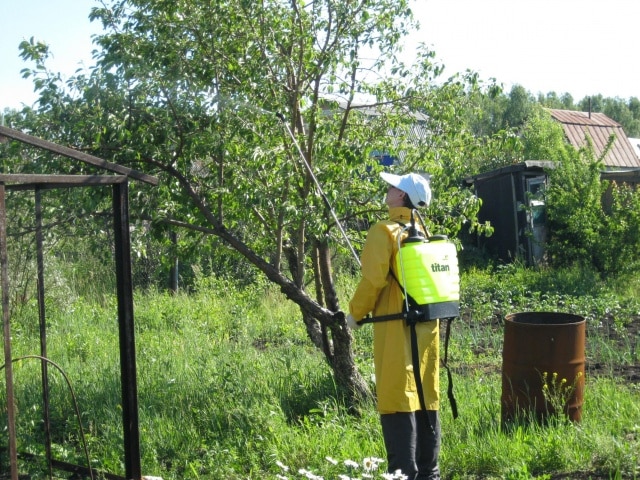
After bud break
After budding, a second treatment is carried out. You can spray trees with Bordeaux liquid or copper sulfate.
During flowering
During flowering, trees are best not treated with insecticides. During this period, it is recommended to collect the web by hand.
During fruiting
If necessary, processing is carried out with biological preparations at least three weeks before harvest. During this time, the substances become harmless.

Final processing
It is held in the fall, after the trees have dropped their foliage. Trees are cultivated in dry, windless weather at + 8-10 ° C. Bordeaux mixture is used for processing, which is easy to purchase at a garden store. Trees are treated without sparing the working solution. They also spill the soil around the apple tree - to destroy the pupae.
Pest prevention
In the spring, before bud break, you should carefully examine the trees. The larvae, if found, are scraped off by hand. It is necessary to dig in the apple trees and whitewash not only the trunk, but also the lower branches. If a cobweb appears on the branches, it must be collected and burned.
During the spring-summer season, fruit trees should be carefully examined. When a web is found, it is immediately removed and burned.In addition to all the indicated methods, the caterpillars are knocked down with jets of water when watering or shaken off on a cloth or polyethylene spread under a tree, and then burned.
With careful attention to your own garden, its timely processing and the application of a set of pest control measures, the likelihood that apple trees will be seriously affected by caterpillars and other insects is very small. In response to the care, the plants will respond with an enviable harvest.
